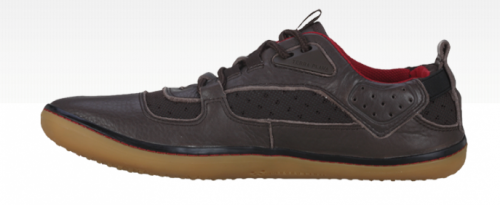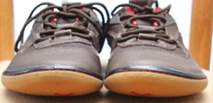By Pete Larson. I’ve gotten a number of emails recently from readers asking about what type of shoe I wear to work. Given that I’ve spent most of the past 4 months either in sandals, barefoot, or in running shoes (i.e., summer attire for a college prof), none of those are likely the answer that most people are looking for. Now, one week into my teaching semester, I’ve had to make the adjustment to being in regular shoes again for most of the day. Fortunately, my work shoe of choice is quite possibly the most comfortable shoes that I own.
 Vivobarefoot shoes have long been a favorite among minimalist runners, but prior to this year I had never tried them. I always thought they looked a bit strange, perhaps because they have a really wide and somewhat rounded toebox. Last winter, my friend Mark Cucuzzella {Natural Running Center’s executive director} offered to send me a pair of Vivobarefoot Aqua shoes from his store (Two Rivers Treads). He is a big Vivobarefoot fan, and wears their shoes regularly when he’s in the clinic (he’s a family doc in addition to be a shoe store owner). I accepted Mark’s offer, and quickly became a convert.
Vivobarefoot shoes have long been a favorite among minimalist runners, but prior to this year I had never tried them. I always thought they looked a bit strange, perhaps because they have a really wide and somewhat rounded toebox. Last winter, my friend Mark Cucuzzella {Natural Running Center’s executive director} offered to send me a pair of Vivobarefoot Aqua shoes from his store (Two Rivers Treads). He is a big Vivobarefoot fan, and wears their shoes regularly when he’s in the clinic (he’s a family doc in addition to be a shoe store owner). I accepted Mark’s offer, and quickly became a convert.
When it comes to comfort and ground feel, it’s really hard to beat Vivobarefoot shoes. I now have a variety of Vivos, including the Aquas, Neo, Neo Trail, Achilles sandals, and Ultra, and all have very thin, zero drop soles. As a result, all of them provide a great connection to the ground. Like many of the Vivobarefoot shoes, the Aquas come with a removable insole, and the liner under the insole is finished nicely, with the expectation that many people will use them without it. I measure the sole thickness as 8mm with the insole, 5mm without. To be honest, these shoes are among the best that I own in terms of ground feel, and they feel great underfoot while I’m lecturing or scooting from bench to bench in the lab. Because of the thin sole, flexibility is also excellent – the Aquas can easily be folded into a ball.
 In terms of width, the Aquas also shine. The toebox has ample room and is not restrictive in the least – I’d compare it to a Croc, Birkenstock, or the Altra Instinct in this area. This is much appreciated in a shoe that is on my feet for 8-9 hours straight. The upper is mostly leather, with a few area of mesh that provide a bit of ventilation. The interior is lined by a soft synthetic fabric, and the tongue is elasticized on the sides – the latter is nice as it allows me to use it as a slip-on rather than ever having to mess with the laces.
In terms of width, the Aquas also shine. The toebox has ample room and is not restrictive in the least – I’d compare it to a Croc, Birkenstock, or the Altra Instinct in this area. This is much appreciated in a shoe that is on my feet for 8-9 hours straight. The upper is mostly leather, with a few area of mesh that provide a bit of ventilation. The interior is lined by a soft synthetic fabric, and the tongue is elasticized on the sides – the latter is nice as it allows me to use it as a slip-on rather than ever having to mess with the laces.
In order to justify the list price for the Aquas ($140), durability and quality should be expected, and I can report that these shoes have held up phenomenally. After wearing them for nearly the entire Spring semester, I’ll be darned if I can find any wear at all on the puncture-resistant sole. Wish I could say the same for my other work shoes – I trash the heels on most of my walking shoes (I’m a scuffer when I walk). The uppers still look nearly as good as new as well – nary even a scuff on the leather.
Perhaps the only drawback I have encountered with the Aquas is that they aren’t the best choice in snow. The combination of a lack of traction and the lack of a thick enough sole to raise me above slush level has made for a few treacherous walks from my car up the hill to my office in the winter. I may break down and buy a pair of the new Vivobarefoot Off Road Mid boots for the coming winter.
Conclusion: To say that I love my Aquas would be an understatement. I’ve come to believe that what we wear on our feet for most of the day can have as much, if not more, influence on our foot health as what we wear on a 30 or 60 minute run. My feet are happy spending a full day in my Aquas, and the fact that they are zero drop means that I can take them off at the end of the day and go for a run in a zero drop running shoe without fear that my Achilles and calves will rebel at the abrupt change. From a durability and quality standpoint, the Aquas justify their price and then some. The Aquas are a great, great shoe, and they get my highest recommendation.
This review originally appeared on Pete Larson’s site, Runblogger.
